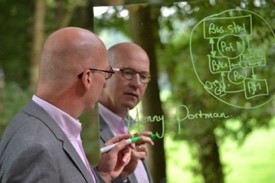Sensemaking in the Agile Forest
SERIES ARTICLE 1
By Henny Portman
The Netherlands
Introduction
Agile is used all over the place as a working method or as a catch-all term. But what is “agile” really? Literally, it means maneuverable, nimble, and flexible. As far as I am concerned, agile is a mindset.
Agile is therefore between your ears: how do you think, how do you act, how do you behave? Do you think for the customer, or do you ask the customer? Do you make all decisions yourself or do you trust the people in a team so that you allow them to make their own decisions? Do you start from a set plan, or do you accept that not everything is clear at the beginning, and do you proceed step by step, allowing yourself to be influenced by the results of experiments and by feedback from the customer? Is making mistakes not allowed or is it allowed to make mistakes as long as we learn from them? Do you go for the most perfect solution or is good, good enough?
Examples of the classical mindset versus the agile mindset can be found in this table.
Manifesto for Agile Software Development
In February 2001, 17 software developers in a ski resort in Utah, United States of America, elaborated on this mindset in the Manifesto for Agile Software Development consisting of four values and twelve principles in order to formulate an answer to the much too slow software development.
We are uncovering better ways of developing software by doing it and helping others do it. Through this work we have come to value:
- Individuals and interactions over processes and tools.
- Working software – nowadays we speak of working products – over comprehensive documentation. Do you first read a manual for your mobile phone, or do you switch on the mobile phone and get to work?
- Customer collaboration over contract negotiation. If you must fall back on a contract when working together, what does that say about the result and/or the cooperation?
- And as a final value, responding to change over following a plan. If a customer wants to implement changes, the result will better meet the needs of that customer, which will increase customer satisfaction.
With all the values, the comment is made that while there is value in the items on the right, we value the items on the left more. So, it is nonsense to say that no documentation or plans are made in agile.
Principles behind the Agile Manifesto
To further define these values, the 17 developers also described twelve principles. These principles can be summarized as follows:
More…
To read entire article, click here
Editor’s note: This is the first article in a new series by Henny Portman, one of the world’s leading authorities on “agile”. Based in The Netherlands, Henny coined the term “agile forest” in 2019 to describe the many agile frameworks that have emerged over the last 20 years. This series is intended to help readers better understand the agile concept, navigate through the ‘underbrush’ and more successfully apply whichever framework is selected for their projects. See Henny’s author profile at the end of this article.
How to cite this article: Portman, H. (2022). What is Agile? Sensemaking in the Agile Forest, series article, PM World Journal, Vol. XI, Issue I, January. Available online at https://pmworldlibrary.net/wp-content/uploads/2022/01/pmwj113-Jan2022-Portman-what-is-agile-sensemaking-in-the-agile-forest-series-article1.pdf
About the Author

Henny Portman
The Netherlands
![]()
Henny Portman, owner of Portman PM[O] Consultancy and was partner of HWP Consulting, has 40 years of experience in the project management domain. He was the project management office (PMO) thought leader within NN Group and responsible for the introduction and application of the PMO methodologies (portfolio, program, and project management) across Europe and Asia. He trains, coaches, and directs (senior) programme, project and portfolio managers and project sponsors at all levels, and has built several professional (PM(O)) communities.
Henny Portman is accredited in a variety of qualifications, including P3O, PRINCE2, MSP, MoP, PRINCE2 Agile, AgilePM, AgilePgM and AgileSHIFT trainer and an SPC4 SAFe consultant and trainer. He is a P3M3 trainer and assessor and PMO Value Ring Certified Consultant (PMO Global Alliance). On behalf of IPMA, he assesses mega and large projects for the IPMA Project Excellence Award. In addition to this, he is an international speaker, author of many articles and books in the PM(O) field, and an active blogger (hennyportman.wordpress.com).
Henny can be contacted at henny.portman@gmail.com
To view other works by Henny Portman, visit his author showcase in the PM World Library at https://pmworldlibrary.net/authors/henny-portman/









